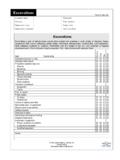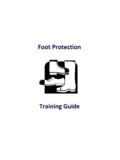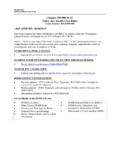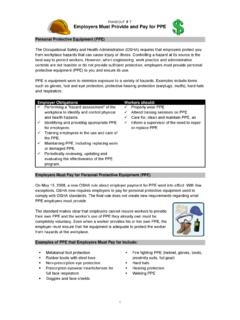Transcription of APPENDIX 6 EUROPEAN STANDARDS AND MARKINGS FOR …
1 APPENDIX 6 EUROPEAN STANDARDS AND MARKINGS FOR foot AND LEG protection ISSUE 8: January 2013 This information is extracted from British STANDARDS with the permission of BSI under licence number PD\1998 1367 INTRODUCTION Harmonised EUROPEAN STANDARDS for Personal Protective Equipment (PPE) have beendeveloped as the preferred means of demonstrating equipment conformity with the basichealth and safety requirements (BHSRs) of the EC Personal Protective Equipment Directive (89/686/EEC). Only equipment which meets these BHSRs is entitled to carry theCE mark and to be sold for use in the EC. The alternative route to obtaining the CE mark involves the manufacturer producing a'technical file' for the equipment which also demonstrates that it satisfies the BHSRs. Insuch cases, the equipment will carry the CE mark but may not display any Standardnumber.
2 The manufacturer's information will contain the performance specification. For Category III PPE (for use against mortal danger ), the CE mark will be accompaniedby a four-digit code number identifying the responsible Notified Body appointed to ensurethat the manufactured product continues to satisfy the BHSRs. Increasingly, EUROPEAN STANDARDS (prefixed EN EUROPEAN Norm) are being superseded or subsumed by International STANDARDS (prefixed ISO). Where these are adopted in theUK, they will also be issued as British STANDARDS and be prefixed BS. The British versionsof STANDARDS (BS EN, BS ISO or BS EN ISO) may have minor differences from the originalversions of the standard, usually in the form of a National Foreword or National Annex, toaccount for legislative or technical variations specific to the UK.
3 If such a UK variationexists, this is flagged up in the attached listings below for the individual STANDARDS . BSversions may also differ slightly in the stated year of issue from the EN or ISO versions;the original EN or ISO issue dates are quoted here. The STANDARDS may contain design, performance and marking requirements for thedifferent types of equipment. This document lists the STANDARDS , and gives a briefexplanation of the MARKINGS which they define. ORGANISATION OF THE INFORMATION PPE STANDARDS are separated into broad categories, depending on the type of protectionintended, eg head protection , foot protection . Separate documents have been producedfor each category. Within a category, where possible, STANDARDS have been further subdivided according to the hazard (eg mechanical hazards, heat and flame) or component type (eg filters;facepieces) as appropriate.
4 Both current and recently superseded versions are listed, asequipment marked according to either version may be encountered in the field. Standard number and date are given, with the title (sometimes abridged). If a UK National variation applies to this standard, the nature of this variation is and classifications defined in the Standard for that class of equipment are listedand briefly described. Related STANDARDS , eg specific test methods which will not usually appear in the markingson equipment are listed separately at the end of each document. Pictograms and symbols for each type of equipment are included at the rear of therelevant document. STANDARDS FOR foot AND LEG protection Footwear EN 345-1:1992 - Safety footwear for professional use - Specification Superseded by EN ISO 20345:2004 Basic requirements - Safety footwear must have a 200J toecap.
5 Other properties: (may not all apply to some designs of footwear) P - penetration resistance C - conductive A - antistatic HI - insulating against heat CI - insulating against cold E - energy absorbing seat region WRU - uppers resistant to water penetration / absorption HRO - outsole resistant to hot contact Classification I - (made from leather and other materials, but not all-rubber or all-polymeric types) SB - basic requirements for safety footwear met S1 - basic requirements plus closed and energy absorbing seat region, and antistatic S2 - as S1 plus water penetration and absorption S3 - as S2 plus penetration resistance and cleated sole Classification II - (all-rubber or all-polymeric types) SB - basic requirements for safety footwear met S4 - basic requirements plus energy absorbing seat region, antistatic S5 - as S4 plus penetration resistance and cleated sole EN 345-2:1996 - Safety footwear for professional use - Additional specifications Superseded by EN ISO 20345, EN 17249 and EN 15090 WR - water resistance for classification I footwear Chainsaw footwear - Pictogram - shield enclosing chainsaw ( ) # - class of protection (0, 1, 2 or 3).
6 Class 0 only applies to classification I footwear until December 1999, after which it will disappear Fire fighting footwear - Pictogram - Fig. 2 with a strip beneath bearing one of the following: F - basic requirements met FP - basic requirements plus penetration resistance FA - basic requirements plus antistatic FPA - basic requirements plus penetration resistance and antistatic Metatarsal protection - M - basic requirements plus metatarsal protection Cut resistance - CR - basic requirements plus cut resistance EN 346-1:1992 - Protective footwear for professional use - Specification Superseded by EN ISO 20346:2004 Basic requirements - Protective footwear must have a 100J toecap. Other properties: MARKINGS as for EN 345-1 Classification I - (made from leather and other materials, but not all-rubber or all-polymeric types) PB - basic requirements for protective footwear met P1 - basic requirements plus closed and energy absorbing seat region, and antistatic P2 - as P1 plus water penetration and absorption P3 - as P2 plus penetration resistance and cleated sole Classification II - (all-rubber or all-polymeric types) PB - basic requirements for protective footwear met P4 - basic requirements plus energy absorbing seat region, antistatic P5 - as P4 plus penetration resistance and cleated sole EN 346-2:1996 - Protective footwear for professional use - Additional specification Superseded by EN ISO 20346.
7 2004 WR - water resistance for classification I footwear M - basic requirements plus metatarsal protection CR - basic requirements plus cut resistance EN 347-1:1992 - Occupational footwear for professional use - Specification Superseded by EN ISO 20347:2004 Basic requirements - Occupational footwear is not required to have a protective toecap. Other properties: MARKINGS as for EN 345-1, plus: ORO - outsole resistant to fuel oil Classification I - (made from leather and other materials, but not all-rubber or all-polymeric types) O1 - basic requirements plus oil resistant sole, closed and energy absorbing seat region, and antistatic O2 - as O1 plus water penetration and absorption O3 - as O2 plus penetration resistance and cleated sole Classification II - (all-rubber or all-polymeric types) O4 - basic requirements plus oil resistant sole, energy absorbing seat region, antistatic O5 - as O4 plus penetration resistance and cleated sole EN 347-2:1996 - Occupational footwear for professional use - Additional specification Superseded by EN 20347:2004 WR - water resistance for classification I footwear BS 4676.
8 2005 Protective clothing footwear and gaiters for use in molten metal foundries Requirements and test methods Superseded by EN ISO 20349:2010 Footwear - manufacturer - product code - size - Type - Type 1 worn with gaiters for MM protection - Type 2 worn on their own for MM protection - BS 4676:2005 - Al and/or Fe for molten metal resistance type - Pictogram (Fig 5) - see instructions ( Fig 8) For Type 1 footwear: Warning: When working with molten metal always fit gaiters conforming to BS 4676 over this footwear Gaiters - manufacturer - product code - size and left/right orientation - Type - Type A extend >295mm up leg - Type B extend >145mm up leg - BS 4676:2005 - Al and/or Fe for molten metal resistance type - Pictogram (Fig 5) - see instructions ( Fig 8) Warning: Wear only in conjunction with footwear conforming to BS 4676 EN 12568:1998 - Requirements and test methods for toecaps and metal penetration resistant inserts Superseded by EN 12568:2010 Toecaps - toecap size - left or right - manufacturers identification - type designation S - for 200 J safety toecap P - for 100 J protective toecap Penetration inserts - insert size - manufacturers identification - type designation EN 12568.
9 2010 foot and leg protectors Requirements and test methods for toecaps and penetration resistant inserts Toecaps - # (5-10) denoting toecap size (10 is largest) - left or right - manufacturers identification - type designation S - for 200 J safety toecap P - for 100 J protective toecap - number of the standard Penetration inserts - insert size - manufacturers identification - type designation - number of the standard EN 13634:2002 Footwear for professional motorcycle riders Superseded by EN 13634: 2010 - Abrasion and cut resistance level 1 or 2 of upper (2 is highest) - Pictogram (Fig. 4) - Indication of impact protected area EN 13634:2010 Protective footwear for motorcycle riders requirements and test methods - size - manufacturer information - type designation - year and at least quarter of manufacture - number and year of the standard - Pictogram (Fig 4) and levels for: - abrasion resistance (1 or 2) - impact cut resistance (1 or 2) - transverse rigidity (1 or 2) In each case, higher number denotes higher performance - Optional MARKINGS of: IPA ankle impact protection IPS shin impact protection WR water penetration resistant FO fuel oil resistant SRA, SRB, SRC slip resistance as per EN 20345 B breathable uppers EN 13832-2:2006 - Footwear protecting against chemicals Part 2.
10 Requirements for footwear resistant to chemicals under laboratory conditions This footwear resists degradation by the stated chemicals (at least 2 from the list below). - size - manufacturer - type designation - year and quarter of manufacture - code for tested chemical(s): B acetone D dichloromethane F toluene G diethylamine H tetrahydrofuran I ethyl acetate J n-heptane K 30% sodium hydroxide L 95% sulphuric acid M 65% nitric acid N 99% acetic acid O 25% ammonia solution P 30% hydrogen peroxide solution Q isopropanol R 13% sodium hypochlorite - toecap strength (200J or 100J) - see instructions ( Fig. 8) - pictogram (Fig 6) optional EN 13832-3:2006 - Footwear protecting against chemicals Part 3: Requirements for footwear highly resistant to chemicals under laboratory conditions This footwear resists degradation (at least 3 stated chemicals) and resists permeation (at least Level 1 resistance for the three stated chemicals).
















